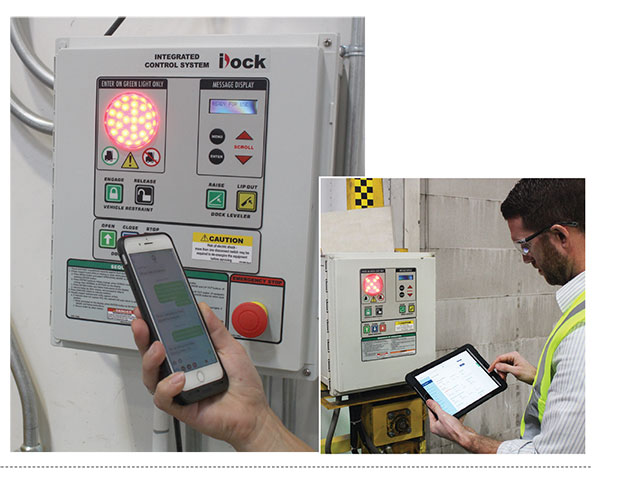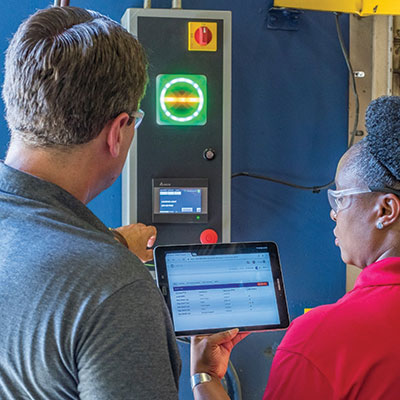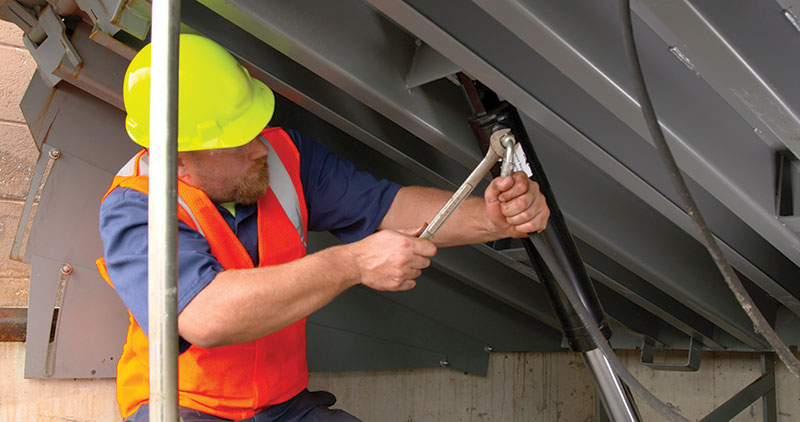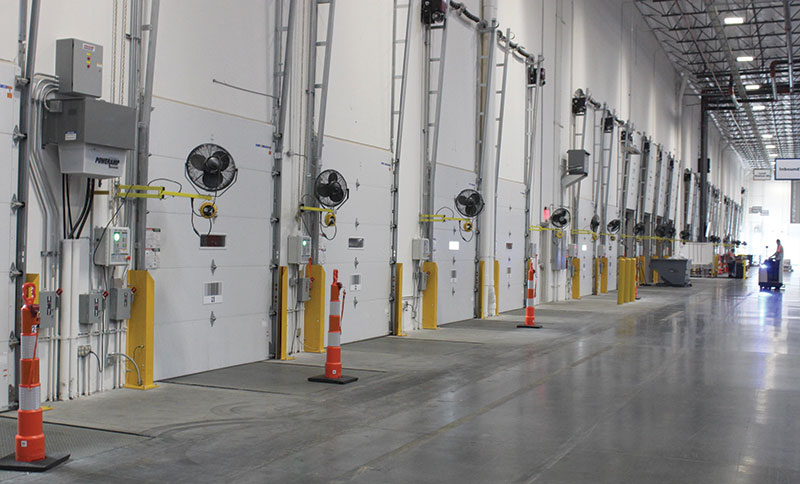Best practices in dock maintenance
If there was ever a bad time for dock maintenance to get in the way of dock flow, this is it. Fortunately, new approaches and technologies are making timely dock maintenance a powerful ally of dock efficiencies.
For the longest time, docks were considered to be a physical part of the facility. A part of the floor even. And not many people pay attention to the floor. Fortunately, that’s no longer the case with docks,” says Walt Swietlik, director of customer relations and sales support at Rite-Hite.
And with that shift, dock maintenance has moved on from a couple of orange cones that block off a leveler to software that identifies docks needing service and can schedule repairs, explains Jeff Schulze, vice president of national accounts and marketing at Systems LLC.
By the way, the software is, as we hear so many times these days, data dependent. The data, collected by sensors built into the dock equipment, notifies the software about any pending problems rather than waiting for a complete and poorly timed breakdown.
The implications of this are substantial.
“The flow at docks has never been more important,” says Rich Lund, president of Perma Tech. “Docks were neglected for a long time. But the demand for goods has been so strong that downtime for a dock has never been more costly,” he adds.
Vanessa Malus, marketing coordinator over at Ideal Warehouse Innovations, puts the cost of a down dock at $1,700 an hour.
Or go to the worst-case scenario: The dock equipment needs to be replaced. “The entire industry is seeing historically long lead times for various types of dock equipment,” says Rich Schlesinger, director of U.S. distribution sales at 4Front Engineered Solutions.
Schlesinger has two words for facility managers in regards to dock maintenance: Do it.
The basics
At its base, dock maintenance comes down to a schedule. Daily, weekly, monthly, quarterly, semi-annually, annually. That hasn’t changed.
The schedule, of course, depends on the maintenance activity and equipment component. For instance, it’s best to check daily for debris that can interfere with the operation of a dock leveler.
Meanwhile, the springs on mechanical levelers should be checked monthly, says Tom Kelly, Perma Tech’s general manager and vice president of sales. Hydraulic leveler cylinders should be checked at least quarterly and the fluid changed once a year, he adds.
And beyond levelers, equipment from vehicle restraints to seals and shelters as well as bumpers all have their own requirements for maintenance attention. Manufacturers offer their recommendations.
At the same time, as supplier Kelly explains, dock equipment maintenance also depends on the industry the facility serves. For instance, the FDA requirements for food distribution centers are especially stringent, all the way down to the need for tight seals to keep insects out. Seals that allow insects indoors triggers its own set of FDA requirements. Needless to say, such standards require a special maintenance schedule for dock equipment.
It’s also important to keep in mind that the quality of the dock equipment purchased in the first place also has an impact on maintenance requirements.
“Since the start of Covid, pricing is not an issue. Instead, quality is what people are most concerned about,” says Lund of Perma Tech. More specifically, that’s quality for a specific application. In other words, the first step to dock maintenance management is buying high quality equipment up front.
“The ultimate objective,” says Malus of Ideal Warehouse, “is to match the dock equipment to the specific application so that it runs safely and effectively for its lifetime. Easy to use and simple to maintain are key here,” she adds.
The importance of use
All of that said, dock maintenance ultimately comes down to use levels. And its not just a matter of daily activity—20 trucks a day, for instance—but the type of activity. A dock that services primarily full truckloads has a different maintenance requirement profile than one primarily used for less than truckload activity.

There’s also the matter of number of docks at the facility. If one of 100 docks goes down, that’s quite different from one of five.
These and other related usage conditions, including time of day a dock is most active, are difficult to ascertain with a clipboard and make good dock maintenance decisions. There’s just too much opportunity for data to never become information.
Clearly, data is at the core of effective dock maintenance today. Fortunately, most suppliers now offer tools that collect, analyze and act on that data to make better maintenance decisions before a dock goes down.
“These systems have increased awareness of dock maintenance needs, forced companies to follow schedules, and ultimately changed how people manage maintenance from repair parts to the techs themselves,” says Rite-Hite’s Swietlik.
“These systems are so knowledgeable that a maintenance tech typically knows what the problem is and how to fix it before arriving at the dock,” says Schulze of Systems LLC.
And, yes, all of this has led to a shift in how techs work. All for the better. Details in a minute.
A range of systems
Despite the power behind these systems, experts agree that larger companies with large numbers of docks are the primary users of them. “However, usage is starting to filter down to smaller companies,” says Schulze.
Here’s a sampling of offerings from three suppliers.
Schlesinger says that 4Front’s product, under the 4SIGHT Connect brand, is called Digital Dock. The system combines a digital master control panel with dock management software.

The process begins a guided sequence of operations that ensures the trailer is properly restrained and ready to carry loads over the dock leveler. The system then monitors and records all activities in real time, including cycle count, load time, time at dock and overrides. It offers operational insight and ability to improve their processes and manage proper maintenance activities.
Rite-Hite’s offering here is known as Opti-Vu. The software collects key activity data at each dock in the facility, ultimately using it to help identify maintenance needs, says Swietlik.
The dock management offering from Systems LLC is myQ Dock Management. “It allows managers to analyze dock activity and efficiency in real time and send text/mail notifications of special events,” says Schulze. The company’s iDock controllers and universal iDock Link connects data from all docks at the facility, creating a single, unified view in the Cloud of myQ Dock Management data.
Regardless of the specifics of these and other offerings, the intent is to both monitor and control dock activities as they occur while building a database that can also guide maintenance activities in the future.
As Schulze points out, people can’t help but be impressed when a dock monitoring system sends a text or e-mail automatically. The story he tells is of a dock that had its power turned off unexpectedly, shutting it down with a trailer in place. By the time the techs arrived at the dock, they not only knew what the issue was, but how to handle it.

There is still another major advantage to these systems. While still firmly set in preventative maintenance schemes, facility managers will become able to build the database needed to move on to predictive maintenance.
That shift, which will take a while, is not here yet. But in the future, it will allow dock management to migrate to maintenance programs that anticipate operational issues before they cause downtime right down to the component level.
The effect on techs
As docks become increasingly interconnected based on data, the same is happening with the maintenance techs themselves.
As was just mentioned, the systems can notify the techs before they arrive at a dock as to what the problem is and potentially how to fix it. But it goes beyond that.
This database build also allows techs to pre-determine the best day and time to fix a non-critical maintenance issue. For instance, the activity log shows that Dock No. 6 is least used on Wednesdays between 2:15 p.m. and 4:40 p.m. That allows techs to preform maintenance when it has the least impact on product flow at the dock.
Such scheduling data also helps to manage the time of techs, many of whom are not resident on-site. Do it right, and a tech won’t need to sit and wait for 45 minutes before a dock can be freed up from unloading a trailer. Whether the tech is in-house or out-sourced, the battle remains to maximize that person’s time performing service, not sitting around, says Schulze.
Techs benefit when given new options to maximize their call time, especially when they may need to troubleshoot an issue, says 4Front’s Schlesinger. He describes a system, similar to Apple’s FaceTime, that allows the tech to show an expert at a remote location exactly the condition of a dock component. In turn, that expert can then walk the tech through steps and procedures to solve the problem on site—and in the least amount of time.
As it turns out, “on site” and “least amount of time” are perhaps the two phrases that are most top of mind these days in dock maintenance. And with the latest technology advances, more and more data is making both possible.

Article Topics
Dock Equipment News & Resources
Advance Lifts marks 50th anniversary Rite-Hite ONE digital platform debuts How to modernize your dock operations…and why you want to ASSA ABLOY acquires Integrated Warehouse Solutions in the U.S. Destination: Loading dock safety Miner Limited, an OnPoint Group company, acquires Bob’s Overhead Door Miner Limited acquires Central State Door Service More Dock EquipmentLatest in Materials Handling
Geek+ and System Teknik deploy PopPick solution for pharmacy group Med24.dk Beckhoff USA opens new office in Austin, Texas Manhattan Associates selects TeamViewer as partner for warehouse vision picking ASME Foundation wins grant for technical workforce development The (Not So) Secret Weapons: How Key Cabinets and Asset Management Lockers Are Changing Supply Chain Operations MODEX C-Suite Interview with Harold Vanasse: The perfect blend of automation and sustainability Consultant and industry leader John M. Hill passes on at age 86 More Materials HandlingAbout the Author
Subscribe to Materials Handling Magazine

Find out what the world's most innovative companies are doing to improve productivity in their plants and distribution centers.
Start your FREE subscription today.
April 2024 Modern Materials Handling

Latest Resources












